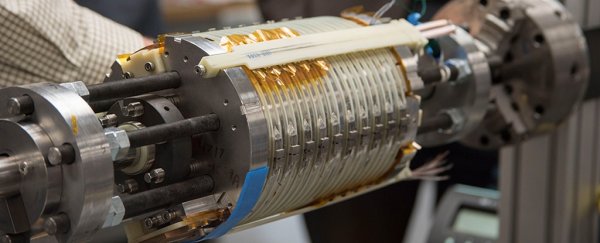If you want to stick something on your fridge, like really get it stuck on hard there, you might want to talk to the scientists at the National High Magnetic Field Laboratory. They've just build the most powerful superconducting magnet ever, shattering the world record.
Its magnetic field clocks in at 32 tesla in strength. That's 33 percent higher than the previous record, and 3,000 times stronger than a small fridge magnet, making this a larger increase than all the improvements in superconducting magnets from the last 40 years combined.
"This is a transformational step in magnet technology, a true revolution in the making," said MagLab Director Greg Boebinger.
"Not only will this state-of-the-art magnet design allow us to offer new experimental techniques here at the lab, but it will boost the power of other scientific tools such as X-rays and neutron scattering around the world."
The new magnet is called the 32T, and it's made of a combination of low-temperature and high-temperature superconductors - materials that conduct electricity frictionlessly, as opposed to a material such as copper, which loses power and generates heat in the process.
Magnets that are made of these resistive materials are called resistive magnets, and they can be very powerful; in fact, MagLab created (another record-breaking) one earlier this year that generates a magnetic field of 41.4 tesla.
But because they lose so much energy, the energy requirements to power them are much higher than what is needed for a superconducting magnet. That 41.4-tesla magnet takes a whopping 32 megawatts of direct current power to run.
Low-temperature superconductivity was discovered in 1911, but it's not without limitations. As the name suggests, it only works below a certain temperature threshold - usually around 20 Kelvin (-253.15 Celsius or -423.67 Fahrenheit).
This means that the superconducting magnets that power MRI machines in hospitals require liquid helium to keep the magnet at operating temperature - a costly solution, but still more economical than the power requirements of a resistive magnet of the same strength.
These low-temperature superconductors also stop working at magnetic fields higher than about 25 tesla.
But then high-temperature superconductivity was discovered by IBM researchers Georg Bednorz and K. Alex Müller in 1986. Not only do high-temperature superconductors work at a wider range of temperatures ("high" being relative), they also work in stronger magnetic fields.
By combining the two, the team at MagLab were able to create a powerful superconducting magnet that overcomes the limitations of low-temperature materials.
32T uses a conventional low-temperature superconductor, and a high-temperature superconductor called YBCO made of yttrium, barium, copper and oxygen, which has a critical temperature of about 93 Kelvin (-180 Celsius or -292 Fahrenheit - we told you it was relative).
The magnet took years to design, and the team developed new techniques for insulating, reinforcing, and de-energising the system. Now that they have those techniques, they can try to develop the magnet even further.
"We've opened up an enormous new realm," said Huub Weijers, who oversaw the magnet's construction.
"I don't know what that limit is, but it's beyond 100 tesla. The required materials exist. It's just technology and dollars that are between us and 100 tesla."
The new magnet will be available for use to visiting scientists from next year, and is expected to help break new ground in a variety of areas, including chemistry, biology, physics, and quantum matter.
